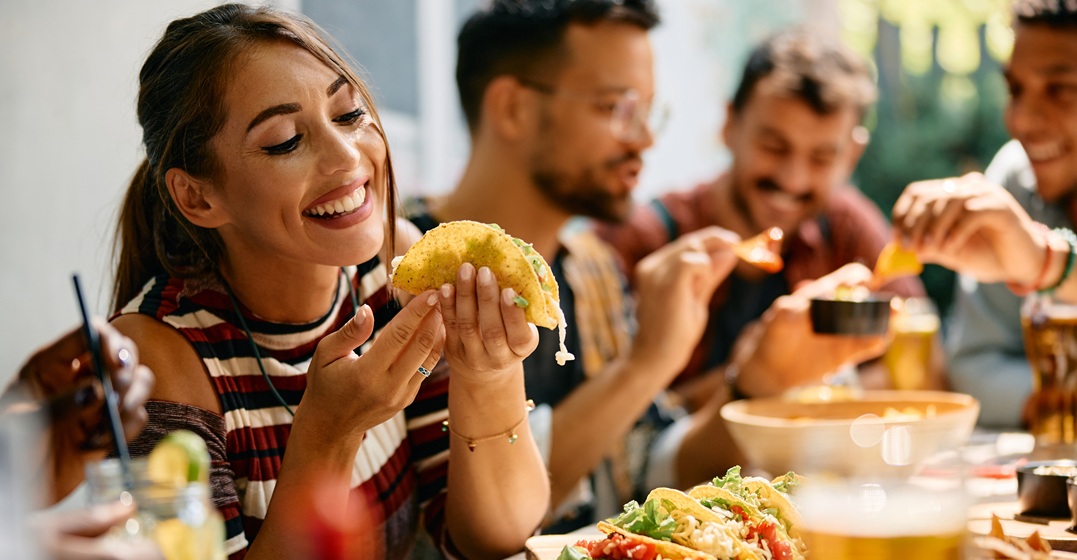Essential Spanish food terms for every situation

Spanish-speaking countries are known for having some of the most amazing flavors around the world. You’re probably already highly motivated to learn at least some basic Spanish food vocab.
From being able to buy groceries and order food in Spanish to becoming familiar with local eating habits, you’ll quickly see that getting food words in Spanish down will open up a new (and delicious) world to you. So, let’s feed that appetite and take a look at this comprehensive food glossary!
- Core Spanish food vocabulary
- Beverages in Spanish
- Sweet treats and desserts
- Dishes and meals in Spanish
- Flavors and cooking terms in Spanish
- Understanding Spanish mealtimes and food culture
- FAQs
Core Spanish food vocabulary
As an appetizer, we’ll start with essential Spanish food vocab. These are Spanish words you need to know to go shopping, order food at Spanish-speaking restaurants and even talk about dietary restrictions or allergies.
Let’s dive into how to say the most common vegetables, proteins and fruits in Spanish:
Vegetables (verduras / vegetales)
| Spanish | English |
| aguacate | avocado |
| alcachofa | artichoke |
| apio | celery |
| berenjena | eggplant |
| brócoli | broccoli |
| cebolla | onion |
| cilantro | cilantro |
| champiñón | mushroom |
| col/repollo | cabbage |
| elote (Mexico)choclo (Central & South America)maíz (Spain) | corn |
| espárragos | asparagus |
| espinacas | spinach |
| jitomate (Mexico)tomate (general) | tomato |
| lechuga | lettuce |
| papa (Latin America)patata (Spain) | potato |
| pepino | cucumber |
| pimiento | pepper |
| rábano | radish |
| zanahoria | carrot |
Here are example sentences using these words:
- Soy alérgico/a a la cebolla (I’m allergic to onion).
- Me encanta la lasaña de berenjena (I love eggplant lasagna).
- En México comen mucho rábano (They eat a lot of radish in Mexico).
- No me gustan las espinacas (I don’t like spinach).
Fruits (frutas)
| Spanish | English |
| cereza | cherry |
| ciruela | plum |
| durazno | peach |
| frambuesa | raspberry |
| fresa | strawberry |
| guayaba | guava |
| higo | fig |
| lima | lime |
| limón | lemon |
| mango | mango |
| manzana | apple |
| melón | melon |
| mora azul | blueberry |
| naranja | orange |
| pera | pear |
| piña | pineapple |
| plátano | banana |
| sandía | watermelon |
| toronja | grapefruit |
| uva | grape |
| zarzamora | blackberry |
- Adriana hace un pay de manzana delicioso (Adriana makes a delicious apple pie).
- El jugo de naranja me hace daño (Orange juice doesn’t sit well with me).
- El vino está hecho de uvas (Wine is made of grapes).
Proteins (proteínas)
| Spanish | English |
| atún | tuna |
| carne | meat |
| carne de res | beef |
| cerdo | pork |
| chorizo | chorizo |
| cordero | lamb |
| jamón | ham |
| pavo | turkey |
| pescado | fish |
| pollo | chicken |
| salchicha | sausage |
| salmón | salmon |
| tocino | bacon |
- No como carne, soy vegetariana/o (I don’t eat meat, I’m a vegetarian).
- Me gustan los waffles con tocino (I like waffles with bacon).
- La salchicha alemana es la mejor (German sausage is the best).
Grains (granos), nuts (nueces) and staple foods
| Spanish | English |
| aceite | oil |
| aceituna | olive |
| almendra | almond |
| arroz | rice |
| azúcar | sugar |
| especias | spices |
| cacahuate (Mexico)maní (South America/Caribbean)cacahuete (Spain) | peanut |
| cátsup | ketchup |
| frijoles | beans |
| garbanzos | chickpeas |
| lentejas | lentils |
| masa | dough |
| mayonesa | mayo |
| mostaza | mustard |
| nuez | walnut |
| pan | bread |
| pasta | pasta |
| pimienta | pepper |
| piñón | pinenut |
| trigo | wheat |
| sal | salt |
| salsa de chile | hot sauce |
| semillas | seeds |
| vinagre | vinegar |
- Mi cerveza favorita es la de trigo (Wheat beer is my favorite).
- Ya no tenemos vinagre (We ran out of vinegar).
- Le hace falta pimienta a la pasta (The pasta is missing some pepper).
- La sopa de lentejas es mi favorita (Lentil soup is my favorite).
Dairy (lácteos)
| Spanish | English |
| crema | cream |
| huevo | egg |
| leche | milk |
| mantequilla | butter |
| queso | cheese |
| suero de leche | buttermilk |
| yogurt | yogurt |
- Desayuno yogurt con fruta (I have fruit with yogurt for breakfast).
- No me gusta el queso fuerte (I don’t like strong cheese).
Beverages in Spanish
How are we gonna wash down all those small-plate tapas? Let’s order some drinks (bebidas)!
Common drinks (bebidas)
| Spanish | English |
| agua mineral (Mexico)agua con gas | sparkling water |
| agua natural | still water |
| café | coffee |
| chocolate caliente | hot chocolate |
| jugo (Latin America)zumo (Spain) | juice |
| leche | milk |
| licuado (Mexico)batido (Spain) | smoothie |
| limonada | lemonade |
| malteada | milkshake |
| refresco / soda | soda |
| té | tea |
| té helado | iced tea |
- Para mí un agua mineral, por favor (Sparkling water for me, please).
- Siempre ceno un licuado de plátano (I always have a banana smoothie for dinner).
Alcoholic beverages (bebidas con alcohol)
| Spanish | English |
| alcohol | alcohol |
| botella | bottle |
| cerveza | beer |
| cerveza de barril | draft beer |
| champaña (LatAm)champán (Spain) | champagne |
| cóctel | cocktail |
| ginebra | gin |
| shot (general)chupito (Spain) | shot |
| sidra | cider |
| vino | wine |
| vodka | vodka |
| whiskey | whiskey |
- Me da, por favor, una cerveza de barril (Can I get a draft beer, please?).
- El alcohol me causa resaca (Alcohol gives me a hangover).
- La sidra es muy suave (Cider is very smooth).
Pro tip: If you want to work on your Spanish vocabulary, joining classes is a game-changer. At Lingoda, you’ll learn vocab in an immersive manner. You can focus on speaking from day one and practicing real-life conversation skills. Plus, you can set your schedule however works best for you and choose between small group or private Spanish lessons.

Learn Spanish with Lingoda
How it works

Sweet treats and desserts
We’re approaching the end of our meal. If you fancy something sweet, take a moment to learn these food words in Spanish for sweet treats and desserts:
Popular Spanish desserts (postres)
| Spanish | English |
| churros | churros |
| flan | flan |
| torrijas | French toast |
| leche frita | fried milk pudding |
| roscón de reyes | Kings' day circle bread |
| arroz con leche | rice pudding |
| tarta de Santiago | Santiago almond-flour cake |
- ¿Tienen churros con chocolate? (Do you have churros with chocolate?).
- El roscón de reyes se come en enero (Kings’ day bread is eaten in January).
Common sweet ingredients and foods
| Spanish | English |
| azúcar | sugar |
| canela | cinnamon |
| chocolate | chocolate |
| crema chantilly | whipped cream |
| dulce | candy |
| fruta | fruit |
| galleta | cookie |
| gelatina | jelly |
| helado (general)nieve (Mexico) | ice cream |
| hot cakes (Mexico)panqueques | pancakes |
| jarabe | syrup |
| mantequilla de cacahuatemantequilla de maní | peanut butter |
| mermelada | marmalade |
| miel | honey |
| miel de maple | maple syrup |
| crema pastelera (LatAm)natilla (Spain) | custard |
| nata | cream/whipping cream |
| pan dulce | pastry |
| pasta de hojaldre | puff pastry |
| pastel | cake |
| pay de queso | cheesecake |
| tarta (Spain, South America)pay (Mexico) | pie |
| vainilla | vanilla |
- No puedo comer azúcar debido a mi salud (I can’t eat sugar due to my health).
- El chocolate es mi dulce favorito (Chocolate is my favorite candy).
- Prefiero la miel de maple a la de abeja (I prefer maple syrup to honey).
- Se me antoja un sándwich de crema de cacahuate (I feel like a peanut butter sandwich).
Dishes and meals in Spanish
Let’s take a look now at some staple dishes and meal items in Spanish:
| Spanish | English |
| copa | glass |
| ensalada | salad |
| entrada | appetizer |
| guarnición | side dish |
| hamburguesa | hamburger |
| pan tostado | toast |
| plato | dish / plate |
| plato fuerte | main dish |
| postre | dessert |
| sandwichtorta (Mexico) | sandwich |
| sopa | soup |
| vinagretaaderezo | vinaigrettedressing |
- Prefiero la ensalada a la hamburguesa (I prefer the salad to the burger).
- La sopa va antes del plato fuerte (Soup comes before the main dish).
- A la ensalada le falta aderezo (The salad lacks dressing).
Flavors and cooking terms in Spanish
Learning vocabulary for describing flavors and cooking techniques can come in handy in different situations. Want to show appreciation for a meal? Or go through that great Spanish cookbook you got during your last holiday? We’ve got you.
Describing tastes, textures and flavors
| Spanish | English |
| ácido | sour |
| agridulce | sweet and sour |
| aguado | soggy |
| ahumado | smoky |
| bueno | good |
| caliente | hot |
| con hielo | iced |
| cremoso | creamy |
| crujiente | crunchy |
| dulce | sweet |
| fresco | fresh |
| frío | cold |
| grasoso | greasy |
| húmedo | wet |
| jugoso | juicy |
| malo | bad |
| picantepicoso | hot |
| ricodelicioso | delicious |
| rostizado | roasted |
| salado | salty |
| seco | dry |
| suave | soft |
| tibio | warm |
This is how you can talk about flavor, temperature and texture:
- Está muy… picante / rico / salado / dulce (It’s very… spicy / delicious / salty / sweet).
- Está… caliente / frío (It’s… hot / cold).
- Es / Está … crujiente / suave / seco (It’s… crunchy / soft / dry).
Essential cooking verbs
| Spanish | English |
| agregar | add |
| asar | roast |
| poner | put |
| exprimir | squeeze |
| rallar | grate |
| amasar | knead |
| rebanar | slice |
| freír | fry |
| colar | strain |
| colocar | place |
| hervir | boil |
| hornear | bake |
| cortar | cut |
| lavar | wash |
| salpimentar | season |
| descongelar | defrost |
| limpiar | clean |
| marinar | marinate |
| medir | measure |
| mezclar | mix |
| tostar | toast |
| echar | pour |
| pelar | peel |
| pesar | weigh |
| servir | serve |
| untar | spread |
| enfriar | cool |
| picar | chop |
| voltear | flip |
Here are a few examples of how you might see these verbs in recipes:
- Voltea la carne para salpimentar y sírvela caliente (Flip the meat, season it and serve it hot).
- Pica la zanahoria y agrégala a la preparación (Chop the carrot and add it to the mixture).
- Hornea el pay por 45 minutos y sirve cuando aún esté tibio (Bake the pie for 45 minutes and serve it while still swarm).
- Lava el pollo, colócalo en un recipiente y déjalo marinar (Wash the chicken, place in a tray and let it marinate).
- Deja enfriar antes de servir (Let it cool before serving).
Measurements (medidas)
In Spain and Latin American countries, these are the most common measuring units used in cooking:
| Spanish | English |
| grados Celsius | Celsius degrees |
| kilogramo | kilogram |
| litro | liter |
| miligramo | milligram |
| mililitro | milliliter |
| onza | ounce |
| pizca | pinch |
- Horneamos el pastel a 200º por 30 minutos (We bake the cake at 200º for 30 minutes).
- Agregamos una onza de vodka (We add one ounce of vodka).
- Terminamos con una pizca de sal (We finish off with a pinch of salt).
Understanding Spanish mealtimes and food culture
Let’s check out some Spanish food vocab related to mealtimes and discuss some meal habits in Spain and Latin America:
Common Spanish meals and their names
| Spanish | English | Schedule |
| desayuno | breakfast | 7:00-9:00 |
| meriendasnack | snack | 11:00-11:30 and 17:00-18:00 |
| comidaalmuerzo | lunchlunchtime | 13:30 - 15:30 |
| cena | dinner | 21:00 - 22:30 |
| tapas | snacks | 13:30-15:00 or 20:30-22:30 |
- Para la cena habrá sopa de tomate (We’ll have tomato soup for dinner).
- El desayuno es la comida más importante del día (Breakfast is the most important meal of the day).
- Hablamos a la hora de la comida (Let’s talk at lunchtime).
Note: As you can see, dinner in Spain is served rather late compared to American dinner time. That’s why there's snack time (merienda) in the afternoon. On the other hand, tapas are usually served with drinks –so they’re more like bar food.
Typical eating habits in Spain and Latin America
A common thread between Latin American countries and Spain is that lunch is the main meal of the day –this is when you’ll get the most substantial dish. Dinner, however, tends to be lighter.
One major difference is the role wine plays in Spanish food culture. It’s common, for instance, to find a bottle of wine at the lunch or dinner table. Having a glass or two is quite normal. In most Latin American countries, though, wine is mostly saved for the weekends. People don’t drink much alcohol during the working week unless there’s a celebration or a get-together with friends.
How mealtimes vary by region
Just like in Spain, many countries in Latin America –like Mexico and Argentina– also have three mealtimes (breakfast, lunch and dinner). However, in Mexico and Colombia, for example, dinner is served earlier, usually between 19:00 and 21:00. In Argentina, it’s typically between 20:00 and 23:00 (sometimes even later!).
A big difference, though, is that in Spain, kitchens are open only during mealtimes –so it’s not possible to have a meal just anytime you want. In Latin America, for its part, restaurants are usually open throughout the day or in the late afternoon.
What are the names of meals in Spanish?
| Spanish | English |
| desayuno | breakfast |
| meriendasnack | snack |
| comidaalmuerzo | lunchlunchtime |
| cena | dinner |
| tapas | snacks or small plates |
What is a typical Spanish food called?
Spain is home to some of the most mouthwatering food in the world (and fruity wine sangría, of course)! Typical dishes include: tortilla de patatas, jamón ibérico, churros, paella, gazpacho, pimientos padrón, pulpo a la gallega, croquetas and patatas bravas.
Feeling confident and hungry
Whether you’re thinking about moving or traveling to a Spanish-speaking country, learning the most common Spanish food terms –from cooking verbs to kitchen essentials– will help you navigate daily life like a pro. You’ll be able to shop (and chop!), order food at a restaurant and confidently express how much you liked your paella without a problem. And if you’re hungry for more vocabulary, join us at Lingoda today! Our fantastic teachers and focus on real-life conversations will give you the perfect boost.

Learn Spanish with Lingoda
How it works

















